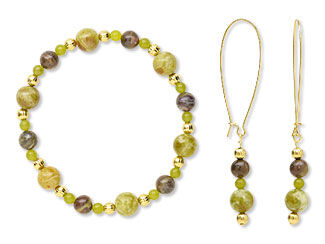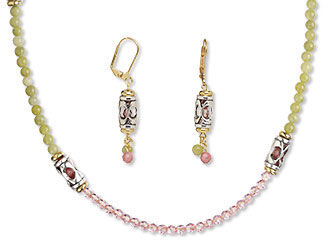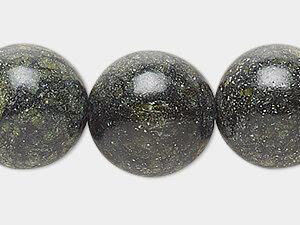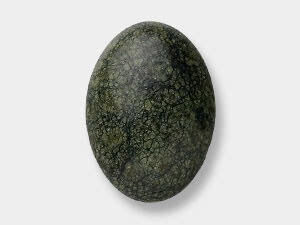Serpentine Meaning and Properties
Serpentine History
Serpentine gemstone, or "precious serpentine," was named in 1564 by Georgius Agricola (Georg Bauer) from the Latin "serpens" for its mottled and scaley appearance like a serpent or snake. It is also known by many trade names such as false jade and Teton jade. Serpentine can also be confused with jade (although serpentine is usually spotted or veined), onyx marble, turquoise and verdite. Fire Mountain Gems and Beads clearly identifies ''new'' jade as a serpentine.
Serpentine is used mainly as a decorative stone or for ornamental objects. Serpentine gemstones have been used as a source of magnesium, in asbestos and for personal adornment or sculpture throughout history. Various serpentine minerals have even been used in architecture for thousands of years.
What are the Metaphysical Properties of Serpentine?
Serpentine is believed to help establish control over one's life. According to metaphysical beliefs, serpentine meaning is associated with a clearing of thought to better facilitate meditation. Serpentine is said to clear clouded areas of the chakras, and serpentine meaning is linked to the crown chakra, promoting spiritual understanding and psychic abilities.
What is Serpentine Made From?
Serpentine is actually a group of magnesium silicate minerals, which are related but have different structures. All variations of serpentine are a basic magnesium silicate, with many containing iron as well. Serpentine may also contain smaller quantities of elements such as chromium, nickel and cobalt. Serpentine is found in two aggregate structures: leafy serpentine (leafy antigorite) and fibrous serpentine (fibrous chrysotile), with very fine fibrous varieties designated as asbestos serpentine. Serpentine has a greasy to silky luster and is sensitive to acids. Colors are often spotty.
Deposits of serpentine are found in Afghanistan, China, New Zealand and the United States.
- Mineral Information: Basic magnesium silicate, sometimes containing other elements
- Chemical Composition: H4Mg3Si2O9
- Color: Green, yellowish, brown
- Hardness: 2-1/2 to 5-1/2 (Mohs)
- Specific Gravity: 2.44 – 2.62
- Refractive Index: 1.560 – 1.571
How Do You Clean Serpentine?
The best method of cleaning serpentine gems and jewelry is to rinse with a mild soap and water (it is not recommended to use steaming, ultrasonic or boiling methods). Wipe with a soft, untreated cloth that is not impregnated with abrasive materials such as rouge. Dry gemstones and settings thoroughly before wearing or storing. Put on your serpentine jewelry after applying cosmetics and perfumes.
Serpentine FAQ
Q: What colors and patterns are most common in serpentine?
A: Serpentine tends to have spotty or mottled patterns in shades of green, brown and yellow.
Q: Is serpentine durable enough for everyday jewelry?
A: With a Mohs hardness of 2-1/2 to 5-1/2, serpentine is a relatively soft stone that should be reserved for use in jewelry pieces like brooches, earrings and necklaces that are not prone to impacts.
Q: Is serpentine sometimes referred to as "false jade"?
A: Serpentine’s resemblance to jade has led it to be called both false jade and Teton jade.
Designing with Serpentine
Because of its green hues and mottled appearance, serpentine is a great alternative to turquoise. Like turquoise, serpentine combines well with amber, sparkling crystals, dyed mountain ''jade,'' Hemalyke™ and, of course, turquoise. And because serpentine can also be confused with jade, onyx marble and verdite, it works well with—or as a substitute for—these gemstones. A variety of serpentine called Russian serpentine, with its black and grey coloring, teams up well with many colors such as the vibrant red of coral.
A Few Design Inspirations to Get You Started
Shop for Serpentine
**Please note that all metaphysical or healing properties listed are collected from various sources. This information is offered as a service and not meant to treat medical conditions. Fire Mountain Gems and Beads® does not guarantee the validity of any of these statements.
How did you like this resource? Your feedback helps us provide resources that matter to you most.
Copyright Permissions
All works of authorship (articles, videos, tutorials and other creative works) are from the Fire Mountain Gems and Beads® Collection, and permission to copy is granted for non-commercial educational purposes only. All other reproduction requires written permission. For more information, please email copyrightpermission@firemtn.com.




